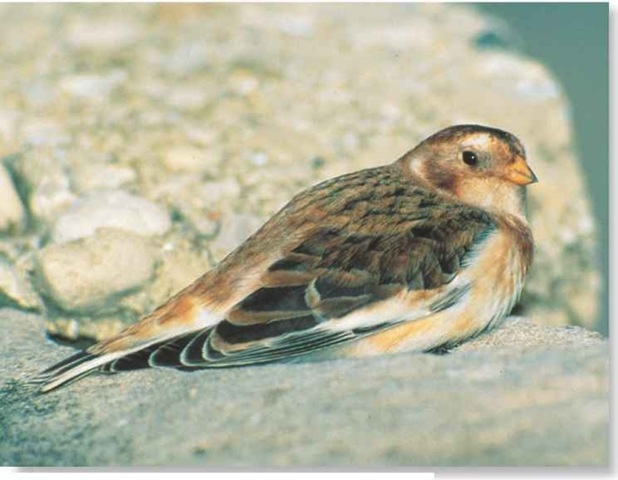ORDER
Passeriformes
FAMILY
Emberizidae
GENUS & SPECIES
KEY FEATURES
The hardy snow bunting nests farther north than any other perching bird Burrows in the snow to withstand temperatures as low as-58°F
Flocks migrate south but will travel only as far as the snow line
WHERE IN THE WORLD?
Found in Iceland, Scandinavia, Scotland, arctic and subarctic Asia and North America; also on islands of the Arctic Ocean and the Bering Sea
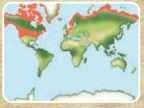
Lifecycle
Despite its diminutive, sparrowlike form, the hardy snow bunting nests farther north than any other member of its order and can endure temperatures from -40°F to -58°F.
Habitat
The snow bunting is aptly named; it rarely ventures far away from cold, snowy terrain. Its summer nests are at the very edge of the icy arctic frontier, and it winters no farther south than areas where snow falls in North America, Asia and Europe. The snow bunting prefers open country, where it feeds on the ground, but it will also seek out haystacks, barnyards and trash piles near lakeshores, as well as dunes, open beaches of seacoast and salt marshes. The snow bunting roosts on the ground, under a shelter of weeds or tufts of grass, or in snow. Snow buntings in North America usually travel no farther south than northern California; because they start so far north, their migration is as arduous as that of birds that winter farther south.
conservation
The snow bunting is not currently threatened, probably due to its often inaccessible arctic habitat. However, the small birds sometimes die in great numbers in nesting areas from May and June snowstorms, which cover its food supply.
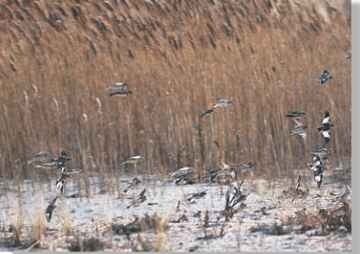
A Friendly flock
Preferring to fly in relatively small flocks, snow buntings hunt for food and travel together.
Breeding
The snow bunting mating season is from late May to July. Most males are monogamous, but polygamy has been recorded. About one-half of pairs raise two broods per year After mating, the female builds her nest out of dead grass, moss and plant stalks lined with animal fur and bird feathers. She prefers to build her nest on the ground in rocky country, stony beaches, sea cliffs or grassy tundra.
The female lays 3-9 eggs, which are bluish or white and marked with brown and lilac spots and speckles. The female alone completes the 10-15 day incubation. After hatching, the young are fed invertebrates, such as mosquitoes, midges, crane flies, moths and spiders; the female provides most of the food. The young reach 90% of their adult weight after about 8 days, and leave the nest from 10-17 days after hatching. Although their arctic habitat and long migration results in a rugged life for the juvenile snow bunting, the hardy young birds are fully able to accompany their parents on the long journey southward.
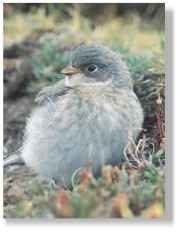
Behavior
The snow bunting can often be seen in small flocks of 20-30 birds, especially when feeding or migrating; entire flocks quickly take to the air if one bird is spooked. The buntings often fly in great, sweeping circles and then return close to the spot from which they took flight. The bird usually stays on the ground, but occasionally perches on boulders. During exceptionally hard winters, the bunting seeks shelter by digging burrows in the snow. In North America, the arrival of snow buntings in large numbers during October and November is a sure sign that winter is coming, much as the robin is a sign of spring.
Rocky resting spot A weary snow bunting takes time out to perch atop a rocky boulder to rest during its long and tiring migration south to relatively warmer areas.
mom at work
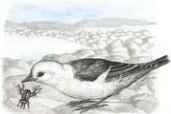
Unburied beetle…
When the last patches of thawing snow reveal the bunting’s rocky habitat, insect prey such as beetles
find it hard to hide.
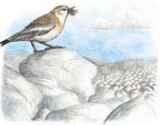
Hunting expedition…
To feed her rapidly growing nestlings, the female hunts among the rocks for an insect dinner, which she clasps in her bill.
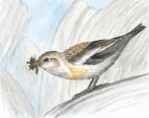
Dinner delivery…
To reach her hidden nest, the female hops down through the crevices and holes among the rocks and boulders in which it was built.
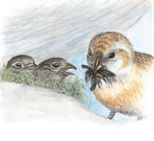
Home at last
Finally perched at the side of the nest after her hunting expedition, the female begins feeding one of the four hungry nestlings.
Only residents on the arctic tundra see the black-and-white breeding plumage of the snow bunting. More familiar are the brown-and-white birds seen farther south.
The snow bunting is one of two species of birds that often receives the nickname snowbird; the other is the dark-eyed junco.
Another nickname for the bunting is “snowflake.”
Food & feeding
In early spring the snow bunting diet consists mainly of compressed seeds, while in summer and fall, the bird also eats spiders and insects, such as beetles, caterpillars and crane flies.Throughout the year, the bunting feasts on a variety of seeds, berries and shoots, preferring grasses, sedges and rushes. In winter, the bird searches for open patches in the snow. It scratches the ground, but will also hop while foraging. If the snow is too deep, the bunting will venture to rocky shorelines to feed on invertebrates such as sandhoppers, sea slaters and sand fleas. In the most severe winter conditions the bunting willingly approaches backyard birdfeeders. The bunting, which tends to feed in flocks, takes protein-rich midges, crane flies, moths and spiders back to the nest for its young.
Summer’s bounty The bunting enjoys a variety of insect prey.
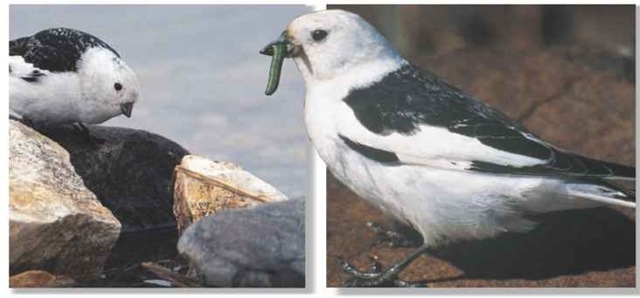
Profile
Snow Bunting
Known as a harbinger of winter when it migrates south, the snow bunting’s white wing patches make it resemble a large, flying snowflake.
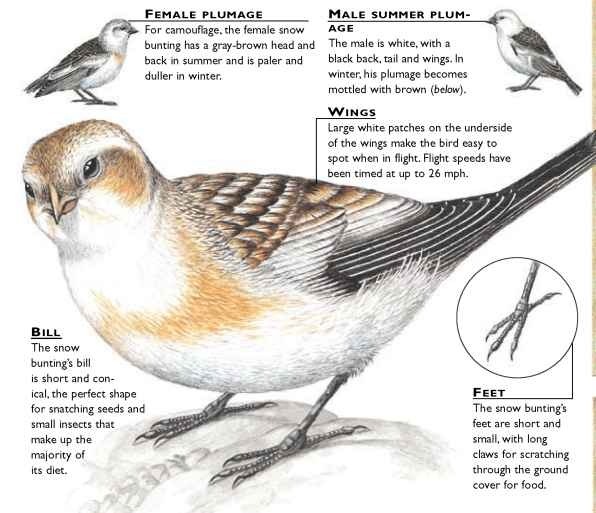
Creature comparisons
Measuring 6″ long from bill to tail, the dark-eyed junco (Junco hyemalis) is about the same size as the snow bunting.There are four subspecies of this junco, with considerable variations in color Females of all subspecies are less colorful than males; all forms have white outer tail feathers, a pale bill, a white belly and dark eyes. The junco, like the bunting, feeds largely on the ground, eating mainly seeds in the winter and adding berries and insects to its summer diet. While northernmost populations of the junco migrate to the southern U.S. in the winter and nest in mountain and boreal forests and edges, the bunting in the U.S. rarely strays farther south than northern California.
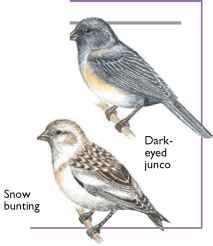
| VITAL STATISTICS Weight 1.25 oz. |
|
| Length | 5-7″ |
| Wingspan | 12-13″ |
| Sexual Maturity | Unknown |
| Breeding Season |
May-July |
| Number of-Eggs | 3-9; usually 4-6 |
| Incubation Period | 10-16 days |
| Fledging Period | 10-17 days |
| Breeding Interval | Up to 2 clutches per season |
| Typical :Diet | Seeds and insects; also spiders and sand fleas |
| Lifespan | Up to 9 years |
RELATED SPECIES
• The snow bunting belongs to the genus Plectrophenax. The genus also contains the McKay’s bunting, R hyperboreus, whose male in breeding plumage is the whitest of I all North American songbirds. The lark bunting, Calamospiza melanocorys, offers a sharp contrast as a mainly black bird. The buntings join finches and sparrows in the family Emberizidae, which contains over 270 species.
